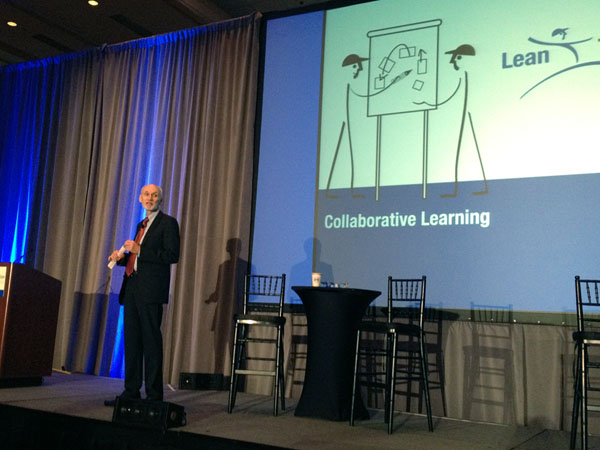 |
| Photo courtesy of Danielle Blais |
John Shook closed the Lean Transformation Summit with a talk on what collaborative learning might mean for lean thinkers. As I wrote in a previous blog, this theme felt lofty for some and concrete enough for others. In Thursday afternoon’s talk, Shook got specific. He expanded upon principles and outlined processes that help us support a culture of collaborative learning in our organizations.
So, what did we learn? Here are some of my take-aways from John Shook’s talk and the Summit on the whole:
The success of collaborative learning requires a different kind of engagement with the work on the part of both the individual and the team.
Most of us hear the term “collaborative learning” and think of two or more people working together, perhaps rather easily. But effective collaboration depends on us thinking (and doing) better alone and better together, and there are processes that can help us do so. Shook reminds us that we’re not just trying to make people feel good: “We’re talking about a method, a process in place with structure, whereby we can learn effectively, borrowing each other’s experience and learning curves to actually create new knowledge as we solve problems.” If we do this, collaborative learning can be powerful, but only if we do this. Shook also cautions us to avoid what he calls “design by committee”; striving for democratic decision-making without also paying attention to gaining agreement (as well as someone taking ownership of the work); and ineffective “brainstorming” which often leads to mindless “groupthink”, something Jonah Lehrer has explored in his research on creativity.
Intent, Process, Practice: A framework that helps us create the conditions for collaborative learning.
Intent is a kind of magical thing. The moment we get clear on our intent, we’ve already begun to make meaningful progress toward our goal. In our lean improvement efforts, taking the time to clarify our purpose for a project and our intent helps us understand what behaviors and processes will allow us to follow through on purpose and intent. “Effective teaching, learning, lean leadership is a matter of choice,” Shook says. And then we need processes to support our intent, “the means by which an intent/decision can be actualized.” And as far as practice goes, Shook reminds us, as they say at the University of Michigan Health System, practice doesn’t actually make perfect; practice makes permanent. It’s more like perfect practice makes perfect. So we must go beyond the tools. We must choose our processes and tools carefully, while still being willing to experiment.
Action (think “series-of-experiments”) trumps endless planning.
With all this talk of intent and process, it’s easy for many of us to get stuck there, right before the practice piece. Stepping into right practice—practice that is consistent with intent, that creates real value for customers and coworkers—requires a balance of supportive lean principles and tools and consistent experimentation. Because at the end of the day, planning only gets us so far. We have to dive into the work. As George Koenig-Sacker reminds us, “It’s easier to act your way into a new way of thinking than to think your way into a new way of acting.” When we think of change management, most of us think about trying to change our thinking or others’ thinking, or our company culture, not the action necessary in order to establish new habits. We need to create new daily routines to create new work habits that support our intent, Shook says. In his brief remarks at the end of day 2, Jamie Bonini, General Manager at TSSC (Toyota Production System Support Center), echoed this idea when he told us that senior leaders are wrong if they think they can go to a conference, read a few books, and then simply “do” lean. Senior executives become well-versed enough in lean to be able to teach it and then make the effort to learn alongside their team members.
With all of these lessons from the Summit in mind, for me, diving into my work differently means translating this idea of collaborative learning into practice by taking those first steps that seem to make sense to me for my own work within my own unique organization.
What were your take-aways? What did you learn (or not learn) at the Summit? What have you done differently in the few weeks since we gathered in Jacksonville? For folks who weren’t able to attend the Summit, find us on Facebook and Twitter. We’re curious to hear your thoughts!






